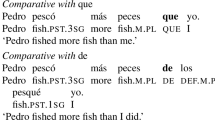Abstract
This paper looks at one area of potential crosslinguistic variation in comparatives. It has recently been claimed that Japanese clausal comparatives lack degree abstraction structures in the complement of yori ‘than’. Based on data from several empirical domains such as predicative adjectival comparatives, intensional contexts, and negative islands, this paper shows that Japanese clausal comparatives do not in general contrast with their English counterparts in the way predicted by the above claim. The syntactic and semantic phenomena observed in Japanese clausal comparatives receive straightforward accounts if we assume that they do involve degree abstraction and degree comparison, along the lines familiar from analyses of their English counterparts.
Similar content being viewed by others
References
Aihara, Masahiko. 2007. Japanese superlative constructions: Evidence for ‘est’-movement. In Proceedings of NELS 37, 1 Vol, 87–100. Amherst: GLSA, University of Massachusetts.
Bale, Alan Clinton. (2008) A universal scale of comparison. Linguistics and Philosophy 31: 1–55
Barker, Chris. (2007) Parasitic scope. Linguistics and Philosophy 30: 407–444
Beck, Sigrid, Sveta Krasikova, Daniel Fleischer, Remus Gergel, Stefan Hofstetter, Christiane Savelsberg, John Vanderelst, and Elisabeth Villalta. 2009. Crosslinguistic variation in comparison constructions. In Linguistic variation yearbook 9, ed. Jeroen van Craenenbroeck and Johan Rooryck, 1–66. Amsterdam: John Benjamins.
Beck, Sigrid. Toshiko Oda, Koji Sugisaki. (2004) Parametric variation in the semantics of comparison: Japanese vs. English. Journal of East Asian Linguistics 13: 289–344
Bhatt, Rajesh, and Shoichi Takahashi. 2007. Direct comparisons: Resurrecting the direct analysis of phrasal comparatives. In Proceedings of SALT 17, 19–36. Ithaca: CLC Publications.
Bhatt, Rajesh, and Shoichi Takahashi. 2008. When to reduce and when not to: Crosslinguistic variation in phrasal comparatives, handout for talk at GLOW 31, Newcastle University, March 2008.
Bhatt, Rajesh, and Shoichi Takahashi. 2011. Reduced and unreduced phrasal comparatives. Natural Language and Linguistic Theory. doi:10.1007/s11049-011-9137-1.
Fox, Danny. (2000) Economy and semantic interpretation. MIT Press, Cambridge
Gajewski, Jon. 2009. More on quantifiers in comparative clauses. In Proceedings of SALT 18, ed. Tova Friedman and Satoshi Ito, 340–357. Ithaca: CLC Publications. http://hdl.handle.net/1813/13043.
Graves, Edward. 2011. The Korean kes construction: An asymmetry in syntax. Honours thesis, McGill University.
Hayashishita, J.-R. 2009. Yori-comparatives: A reply to Beck et al. (2004). Journal of East Asian Linguistics 18: 65–100.
Heim, Irene. (1985) Notes on comparatives and related matters. Ms., University of Texas, Austin.
Heim, Irene. 2001. Degree operators and scope. In Audiatur Vox Sapientiae: A Festschrift for Arnim von Stechow, ed. Caroline Féry and Wolfgang Sternefeld, 214–239. Berlin: Akademie-Verlag.
Heycock, Caroline. Anthony, Kroch. (1999) Pseudocleft connectedness: Implications for the LF interface level. Linguistic Inquiry 30: 365–397
Higgins, Francis Roger. 1973. The pseudo-cleft construction in English. Doctoral dissertation, MIT. Published by Garland, New York, 1979.
Ishii, Yasuo. 1991. Operators and empty categories in Japanese. Doctoral dissertation, University of Connecticut, Storrs.
Jacobson, Pauline. 1995. On the quantificational force of English free relatives. In Quantification in natural languages, ed. Emmon Bach, Eloise Jelinek, Angelika Kratzer, and Barbara H. Partee, 451–486. Dordrecht: Kluwer.
Kennedy, Christopher. 1997. Projecting the adjective: The syntax and semantics of gradability and comparison. Doctoral dissertation, UC Santa Cruz.
Kennedy, Christopher. 2007. Modes of comparison. In Proceedings of CLS 43, ed. Malcolm Elliott, James Kirby, Osamu Sawada, Eleni Staraki, and Suwon Yoon, 141–165. Chicago: The Chicago Linguistic Society.
Kennedy, Christopher. Jason Merchant. (2000) Attributive comparative deletion. Natural Language and Linguistic Theory 18: 89–146
Kennedy, Christopher, and Jason Stanley. 2009. What an average semantics needs. In SALT 18, ed. Tova Friedman and Satoshi Ito, 465–482. Ithaca: Cornell University. http://hdl.handle.net/1813/13050.
Kikuchi, Akira. 1987. Comparative deletion in Japanese. Ms., Yamagata University.
Kim, Min-Joo. 2004. Event-structure and the internally-headed relative clause construction in Korean and Japanese. Doctoral dissertation, University of Massachusetts, Amherst.
Krasikova, Sveta. 2008. Comparison in Chinese. In Empirical issues in syntax and semantics 7: Papers from CSSP 2007, ed. Olivier Bonami and Patricia Cabredo Hofherr, 263–281. http://www.cssp.cnrs.fr/eiss7.
Lechner, Winfried (2001) Reduced and phrasal comparatives. Natural Language and Linguistic Theory 19: 683–735
Lin, Jo-wang. (2009) Chinese comparatives and their implicational parameters. Natural Language Semantics 17: 1–27
Nissenbaum, Jon. 2000. Investigations of covert phrase movement. Doctoral dissertation, MIT.
Oda, Toshiko. 2008. Degree constructions in Japanese. Doctoral dissertation, University of Connecticut, Storrs.
Pancheva, Roumyana. 2006. Phrasal and clausal comparatives in Slavic. In Formal approaches to Slavic linguistics 14: The Princeton meeting, ed. J. Lavine, S. Franks, M. Tasseva-Kurktchieva, and H. Filip, 236–257. Ann Arbor: Michigan Slavic Publications.
Rullmann, Hotze. 1995. Maximality in the semantics of wh-constructions. Doctoral dissertation, University of Massachusetts, Amherst.
Schwarzschild, Roger. (2008) The semantics of comparatives and other degree constructions. Language and Linguistics Compass 2: 308–331
Sharvit, Yael. (1999) Connectivity in specificational sentences. Natural Language Semantics 7: 299–339
Snyder, William, Kenneth Wexler, and Dolon Das. 1995. The syntactic representation of degree and quantity: Perspectives from Japanese and child English. In Proceedings of WCCFL 13, 581–596. Stanford: CSLI Publications.
Sudo, Yasutada. 2009. Invisible degree nominals in Japanese clausal comparatives. In Proceedings of the 5th workshop on Altaic formal linguistics, ed. Reiko Vermeulen and Ryosuke Shibagaki, 285–295. Cambridge: MITWPL.
Sung, Minji. 2011. Comparative constructions in Korean with two types of -kes constructions. Ms., McGill University.
von Stechow, Arnim. (1984) Comparing semantic theories of comparison. Journal of Semantics 3: 1–77
Xiang, Ming. 2003. A phrasal analysis of Chinese comparatives. In Proceedings of CLS 39, 739–754. Chicago: Chicago Linguistic Society.
Xiang, Ming. 2005. Some topics in comparative constructions. Doctoral dissertation, Michigan State University, East Lansing.
Author information
Authors and Affiliations
Corresponding author
Rights and permissions
About this article
Cite this article
Shimoyama, J. Reassessing crosslinguistic variation in clausal comparatives. Nat Lang Semantics 20, 83–113 (2012). https://doi.org/10.1007/s11050-011-9076-8
Published:
Issue Date:
DOI: https://doi.org/10.1007/s11050-011-9076-8



